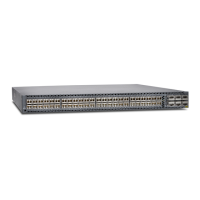Your JTAC engineer might recommend that you check the third-party optic
or cable and potentially replace it with an equivalent Juniper Networks optic
or cable that is qualified for the device.
Table 39: Third-Party QSFP+ DAC Breakout Cable Support
Third-Party DAC Breakout Cable Support AddedPlatform
Junos OS Release 15.1X54-D20ACX5000 router
The cables are hot-removable and hot-insertable. A breakout cable consists of a QSFP+
transceiver on one end and four SFP+ transceivers on the other end. The QSFP+
transceiver connects directly into the QSFP+ access port on the ACX5000 routers. The
cables use high-performance integrated duplex serial data links for bidirectional
communication on four links simultaneously. The SFP+ links are designed for data rates
up to 10 Gbps each. Passive breakout cables have no signal amplification built into the
cable assembly. There are two types of DAC cables:
•
Passive DAC cables have no signal amplification built into the cable assembly.
Table 40 on page 83 describes the passive QSFP+ DAC breakout cable specifications.
•
Active DAC cables have signal amplification and equalization built into the cable
assembly. Table 41 on page 85 describes the passive QSFP+ DAC breakout cable
specifications.
Table 40: QSFP+ DAC Passive Breakout Cable Specifications
SpecificationsProduct SKU
40-Gbps full-duplex serial transmissionRateQFX-QSFP-DACBO-1M
None. SFPs are permanently attached.Connector type
3.3 VSupply voltage
–40
°
C to 85
°
CStorage temperature
TwinaxCable type
30 AWGWire AWG
1 in. (2.54 cm)Minimum cable bend radius
100 ohmsCable characteristic impedance
4.3 nsec/mTime delay
1 m (3.3 ft)Length
83Copyright © 2015, Juniper Networks, Inc.
Chapter 7: Port and Interface Specifications

